Chapter 15
Meet the Twitter Ninja
“No matter how smart or talented you are, you won’t get results without doing the work!”
@AskAaronLee
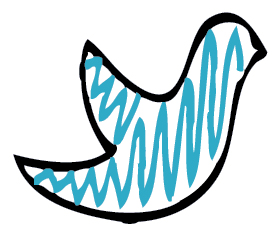
Another young success story is that of Aaron Lee (@AskAaronLee), who is a social media manager, entrepreneur, and as he likes to call himself “an acclaimed ninja hailing from Malaysia.”
Aaron’s clear talent in social media management, coupled with his sincere and open personal brand (see his bio in Figure 15-1), has seen his following on Twitter and many other social media platforms soar over the past two years.
Aaron’s work has been featured on prominent sites such as the Huffington Post and iStrategyConference.com, in which he contributes weekly as a blogger. He has also been listed as one of the top social media personalities on Sprout Social Insights Wall of Fame (see Figure 15-2).
Aaron is the social ninja behind Binkd, a social media marketing platform for promotions, including contests, customer rewards, and incentive programs (see Figure 15-3). This accomplished young man has been featured on numerous blogs and websites, as well as appearing in local newspapers such as the Star Malaysia and Kosmo Malaysia.
Aaron possesses a genuine love for helping people, something that has seen him rank Number 4 in the Top 100 Small Business Experts to Follow on Twitter (see Figure 15-4).
He possesses the spirit of a true entrepreneur, a facet that has recently led him to team with his girlfriend Jin Lee as a cofounder of Leneys, an independent women’s apparel company, shown in Figure 15-5.
Figure 15-1
Aaron Lee’s Twitter bio shows both his work ethic and his humor.

Figure 15-2
Aaron has been listed in Sprout Social Insights Wall of Fame.
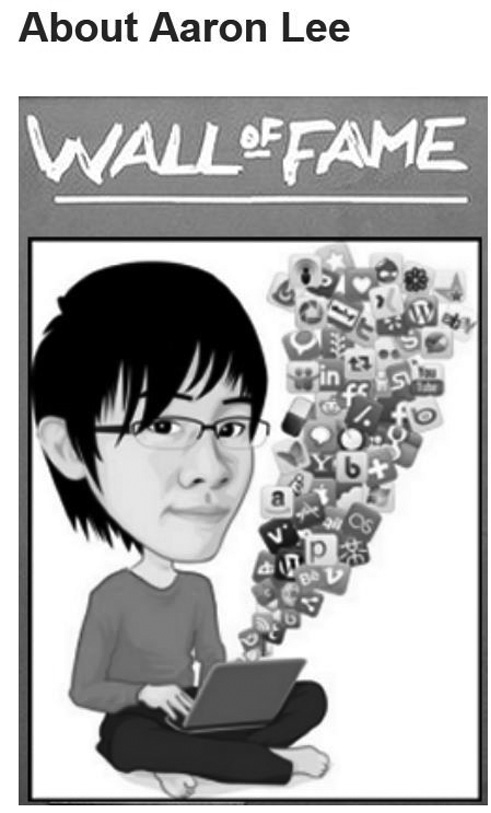
Figure 15-3
Aaron is the social ninja behind Binkd social media promotions and rewards.
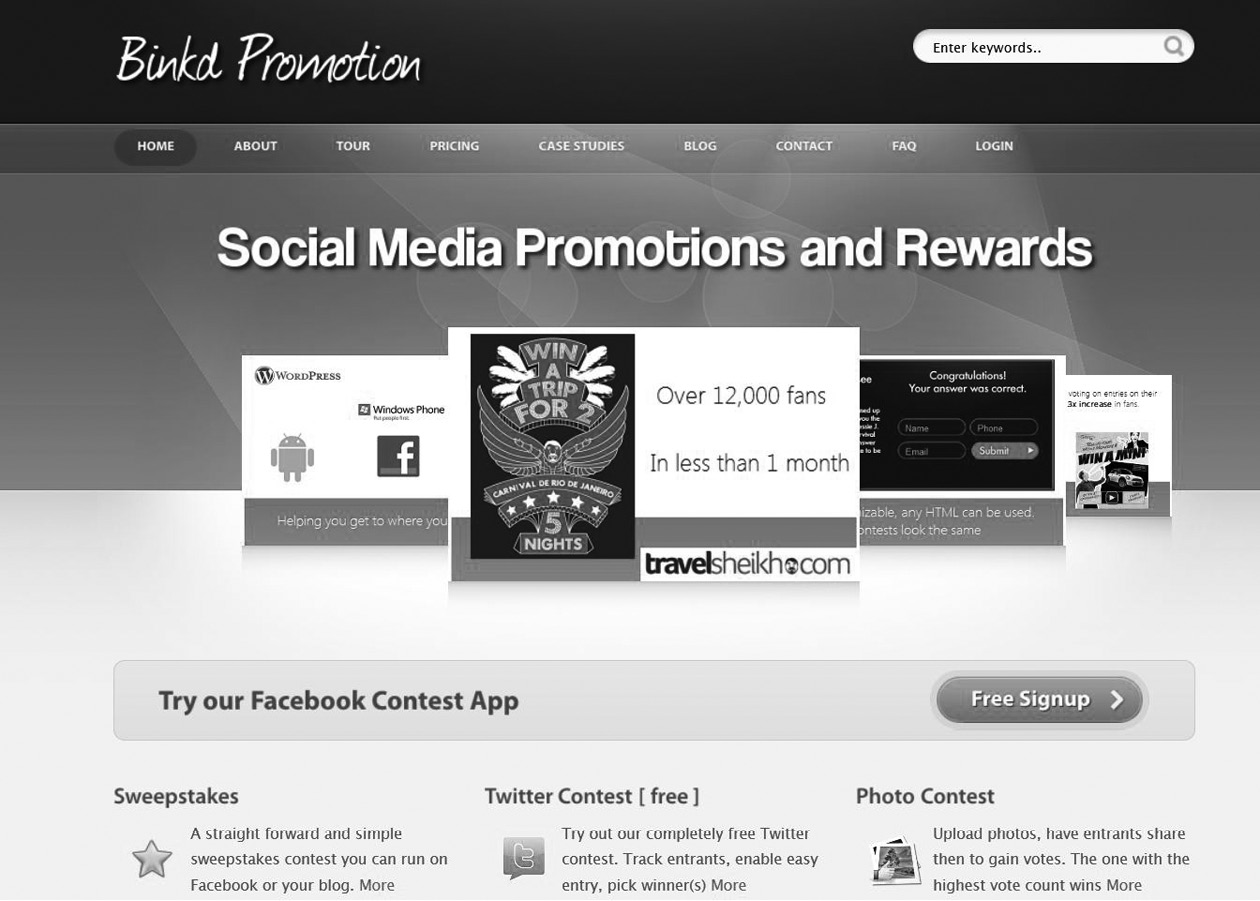
Figure 15-4
Aaron is listed as Number 4 in the Top 100 Small Business Experts to Follow on Twitter.
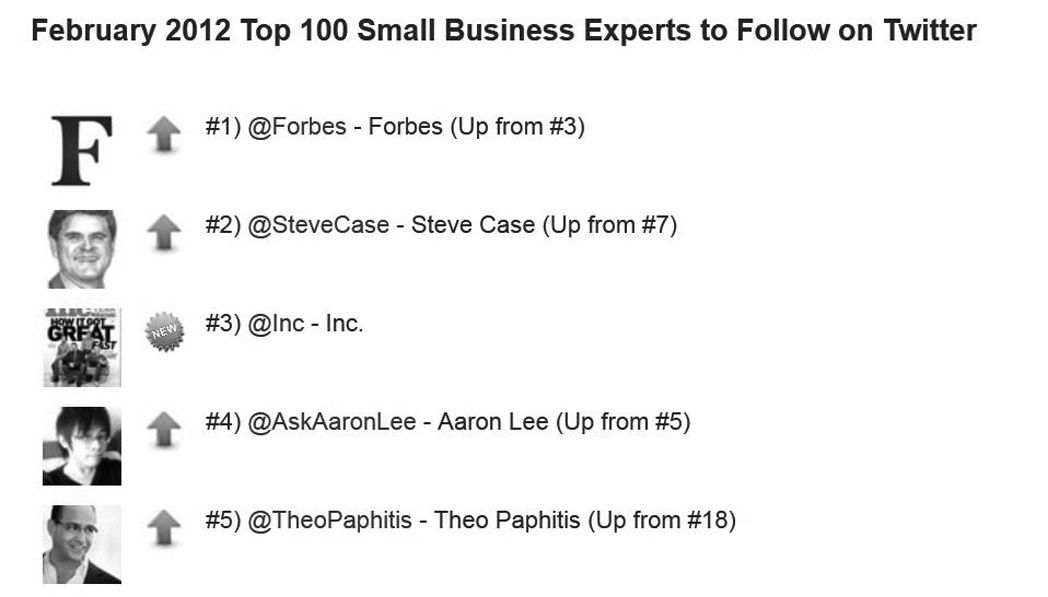
Figure 15-5
Aaron is the cofounder of popular online fashion company Leneys, along with his girlfriend Jin Lee, after whom the business is named.
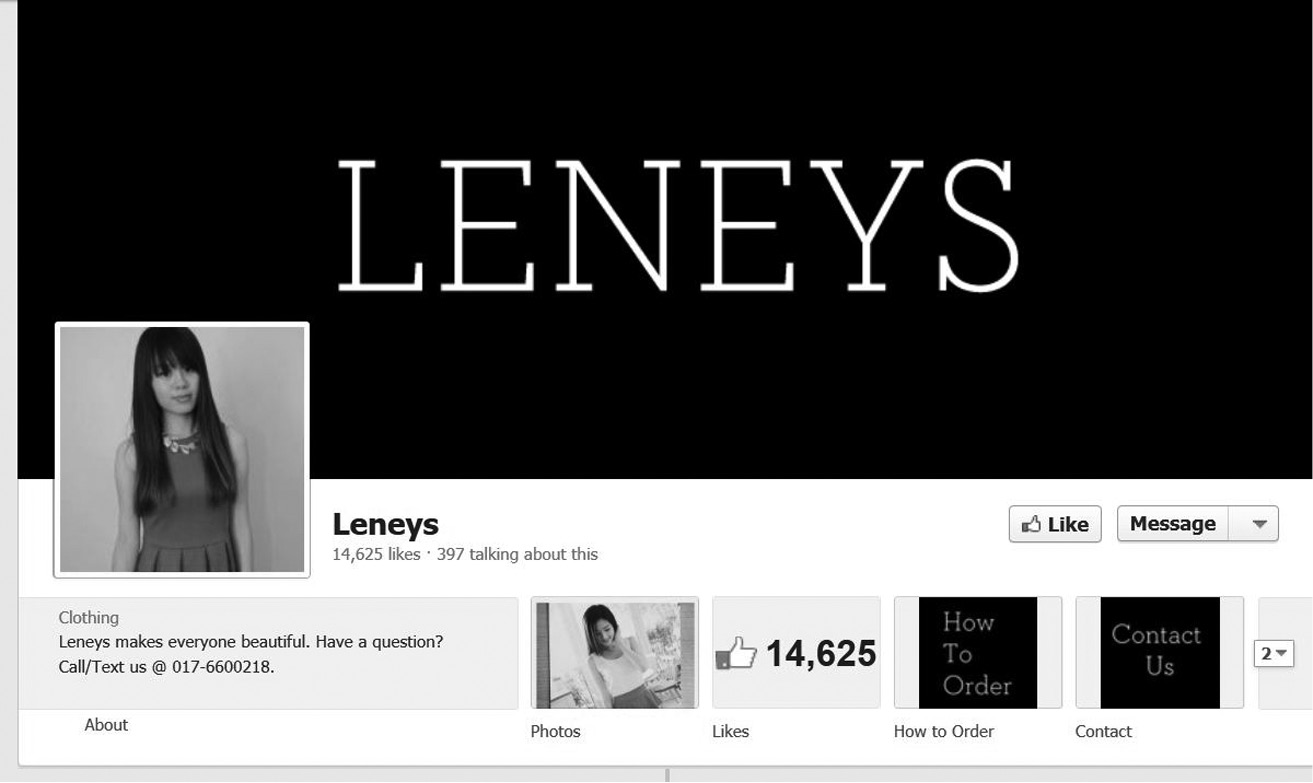
Searching for Possibilities
Aaron’s personal branding success story began back in 2008. He recalls, “It was the holidays and I didn’t want to look for a part-time job, so I searched for alternative ways to make additional income. While at the bookstore one day, I stumbled upon a book about Internet marketing and, after browsing through the first few pages, I was immediately hooked. I read about the possibilities to make income through blogs and other Internet media, so I started a blog about coffee and was blogging throughout my time in the university.”
Because Aaron needed to build traffic to his blog, he looked for ways to get it ranked higher on Google. Doing so took a lot of time and expertise, so he was curious to discover other ways of bringing more attention to his blog. “I remember coming across an article about how Twitter could help me link my blog to other people, and I believed that this was a good idea. I registered in March 2009. At the time, Ashton Kutcher and CNN were battling each other to be the first to get to 1 million followers. Ashton won.”
At first, Aaron didn’t get what Twitter was about. He did, however, notice that some people were using the platform like a diary: sharing their to-do lists, what they just ate, and what they were going to do. So he started to post his own diary-style tweets about his daily life. “I posted tweets like ‘going to class’ or ‘writing a blog post now,’ and a follower responded to my tweets asking me what my blog post was about. After finishing the post, I sent him the link to my blog and he told me that he loved the article. It wowed me!”
Aaron knew that he had stumbled onto something special. He remembers the thrill of that first memorable connection: “Twitter wasn’t like other social networking sites where you are limited to engaging with friends. With Twitter, I am able to connect with just about anyone on earth. Engagement was fun and quick, and I felt like I was in a massive online chat room. It was also easy for me to stay connected to people I liked, as all I needed to do was follow them, no friend requests needed. I’m still connected to some of the people I knew back then, and we’ve been friends ever since.”
Lessons Learned
After using Twitter for a while, and having fewer than 100 followers at that time, Aaron realized that he had only scratched the surface of what Twitter was capable of doing for his personal brand. “I hadn’t been using it at its highest potential. I wanted to know everything about it, so I began reading articles about how to grow my followers. Because Twitter was so new and fresh at that time, there wasn’t much information, and it was difficult to tell what the best way to move forward was.”
Aaron applied some of the techniques mentioned in blogs at the time, such as randomly following people and following everyone back. This proved to be a huge mistake because, although the number of his followers grew, he was clearly following a lot of spammers and bots, too.
“I used to see great tweets from people that mattered, but now all I was seeing were spam tweets about tooth whitening and forex trading. It was an important lesson for me. Because Twitter didn’t have listing options at the time, it was hard to follow meaningful conversations, and I regretted not being able to connect more with the great personalities I had met earlier.”
Luckily enough, Twitter’s list option was launched at the end of 2009 and Aaron was able to vastly improve the way he managed his followers. “I realized that I needed to restructure the way I was growing my profile, so I searched for top social media blogs, followed the most influential people in social media, followed who they were talking to, and who was talking to them. I knew that I needed to know them and I needed them to know me. I responded to tweets, I left comments on their blogs, and I did everything I had to do to get noticed.”
Aaron learned that meaningful interaction and communication were the key to growing a valuable Twitter following.
As Aaron begun sharing information that he’d learned from blogs and other websites, his followers started sharing and retweeting his tweets. He even had people who were keen to ask him questions, as his handle is @AskAaronLee.
He remembers one of the weirdest questions asked was “What is the meaning of life?” “After finding myself repeatedly answering a couple of similar questions about Twitter, I decided to start writing through my blog on January 1, 2010. I wanted to share my experiences with not only my followers but also with people who are looking for it outside of Twitter. From that moment onward, my brand was slowly built to what it is today.”
A Permanent Twitter Connection
Twitter has now become a major part of Aaron’s life and, as such, a part of his personal brand. “It is with me 24/7,” he says. “I can’t remember the last time I’ve not used it. Ever since I started using Twitter in 2009, I am always connected to it.
“Every morning, Twitter is one of the first things I check. I’ll respond to the first couple tweets before I even get out of my bed. I just love the level of engagement I get with people, and I find that I am able to learn so much from so many people around the world. It relaxes me.”
This psychological state of relaxation connected to the feeling of emotional engagement through Twitter is widely acknowledged as one of the reasons for its tremendous success. In fact, the level of engagement on Twitter can’t be compared to other networks, as it is faster and far more personal. Aaron believes that “Facebook and Google+ are great, but Twitter is more personal because every tweet or response in your stream makes an instant emotional connection and feels only for you.”
Aaron also says that he finds it harder to stand out on sites like Facebook and Google+. “When I respond to a wall post or status update, my messages gets mixed with other conversations. But on Twitter, people notice my tweets because they get to view them individually.”
When it comes to creating content on Twitter, Aaron is constantly sharing what he finds interesting and what he feels adds value to others. “It could be a serious-looking article about life, a simple and cheerful infographic, or materials that would make people laugh and brighten their day. Whatever I share, I want it to be meaningful.”
The Benefits of Asking Questions
Aaron believes that the best type of communication and engagement comes from asking questions, adding, “I ask lots of them on Twitter.” He finds that questions asked on Twitter generate a far greater response than when posted on other platforms (see an example in Figure 15-6).
“I noticed that when I ask people to choose between two options, it creates great engagement and buzz. One of the best questions I’ve asked was ‘Which cake would you choose: chocolate or cheesecake?’ In minutes I had hundreds of responses and some who even cheekily answered ‘chocolate cheesecake,’ which was hilarious because I wouldn’t have thought of it.”
Figure 15-6
Aaron has discovered that asking questions is a great way to connect and to create a buzz.

Aaron Lee’s Golden Rules for Personal Branding Success
Aaron has ten best practices for successful personal branding.
1. Have a great profile photo
“One mistake that most newbies make is not having a profile photo up prior to sending out tweets. That is the worst possible way to start on Twitter as it makes them seem like a spammer. People don’t want to talk to a faceless profile or that mysterious Twitter egg.
“Users need to understand that their profile photo is their personal brand on Twitter and all other social networking sites. People remember profile photos even more than they remember usernames.”
2. Get a good username
“Your username on Twitter is your personal brand identity. The best tip I would give is to go for your own name. If it is taken, try adding words that represent what you do or what you want your brand to be. Because I didn’t know what I wanted my branding to be when I got started, I used @AskAaronLee. It is personal because it still has my name in it, it is easy to brand because it is simple, and the .com domain name was available, too.
“I don’t recommend people use a numeric username like @Aaron1202 because names like this are hard to remember, which is bad for branding.”
3. Fill up your bio
“Another mistake that many new Twitter users make is not taking advantage of their bio. Many people on Twitter will check out your bio before deciding whether to follow you or not. I would advise not to fill your bio with too many keywords but to keep the meaning real and true to your brand message.”
Here’s a good bio: “Chieftain of the social web’s most unique blog, {grow}. Consultant, college professor, author of Return On Influence and Tao of Twitter. Social Media Bouncer. @MarkWSchaefer”
Here’s a bad bio: “Social Media | Blogger | Facebook | Twitter | Linkedin”
4. Follow people based on interest first
“To grow a brand on Twitter, you need followers. Otherwise, you’ll feel like a crazy person talking to yourself. Start by following the top people in your industry first. Follow people who are talking to them, and follow who they are talking to. You need to be part of that group and you need people in that group to know you.”
5. Become an expert
“If you want to brand yourself well on Twitter, you need to be an expert on a particular topic. When I started out, most of my tweets were asking for advice about Twitter because I wanted to be an expert on that topic. You need to be the guy that people think about when they are searching for a particular topic.”
6. Share other people’s content
“Most users start by sharing their content to build traffic. Although the logic of branding is to let people know of your presence, I believe that sharing too much of your own content is the wrong way start branding. You need to share other people’s content so they will notice you by making sure that you add their Twitter usernames in your tweets. The best formula is to have a consistent ratio. For example, for every one tweet about your brand, share eight tweets about other people’s content. You don’t like meeting people who only talk about themselves, so start by letting people know that you are willing to listen and share.”
7. Participate
“What makes Twitter great? The conversation. Twitter is a great place to not only build relationships but create engagement. Yes, you will need to share content; however, creating conversations is equally important. You can tweet to the people in your industry, respond to tweets they post, answer any questions they ask, or even ask them questions. The key is to participate.”
8. Be consistent
“Every user needs to develop a consistent habit on Twitter when it comes to tweeting, responding to other tweets, and most important, showing up on Twitter. Many newbies use Twitter only for a couple of weeks, give up, and say that it doesn’t work. You’ll only stay in shape if you eat healthy and exercise constantly, and it is the same when it comes to Twitter. For your account to be healthy, you need to spend time and effort on it.”
9. Help others
To grow a strong brand, help others. To find out what people need help in, you can search on Twitter and find the questions people are asking. Find questions that nobody else might be answering. A good example is Gary Vaynerchuck (@garyvee), who started out on Twitter by searching for those asking questions about wine and answering all of them.”
10. Have fun
“Last, just have fun as you go along. If you aren’t having fun, you won’t enjoy using Twitter and you won’t stay the course, which is vital for personal brand success.”
Aaron Lee’s Favorite Twitter Tools
As with all the personal branding superstars in Part Four, I asked Aaron what tools he finds the most valuable in managing his Twitter presence.
“I tend to get this question a lot,” he remarked. “People want to know what the best tool to use is. My answer will always be that the best tool is right in front of them and it’s free. It’s called Twitter.com. What not many people know is that they are able to do almost everything on Twitter itself. The website comes with a great search tool; you can search for users to follow or even track conversations about a particular topic. I still use the search tool even though I have seen and tested many other external tools for Twitter. I find that the most important tool will always be Twitter itself, because Twitter wasn’t built to be managed by external tools, Twitter was built to be self-sustainable. I believe that every user should get to know the functionality of Twitter.com before they decide if an external tool is required to manage their account.”
Aaron also believes that too much time is spent on finding the right tools to manage Twitter instead of focusing on the real magic of Twitter itself. Having said that, Aaron acknowledges that there are tools that help to ease work on Twitter. He believes the best fit ultimately depends on what users of Twitter want to achieve. Aaron’s personal favorite is CoTweet (see Figure 15-7). “I have tried and tested many tools, but one that got me to continue using it even today is CoTweet. I’ve been a fan of CoTweet since I started using it in 2010.
“What CoTweet does that many other tools aren’t able to do is to group my replies. As my Twitter stream becomes busy with retweets and group chats, I might want to focus on other tweets that were sent directly to me prior to a question. CoTweet allows me to separate the retweets and the direct @askaaronlee replies. This helps me to focus on separate sessions of conversations and helps me improve the quality of my engagement.”
Figure 15-7
CoTweet’s unique features help Aaron focus on the quality of his engagement.
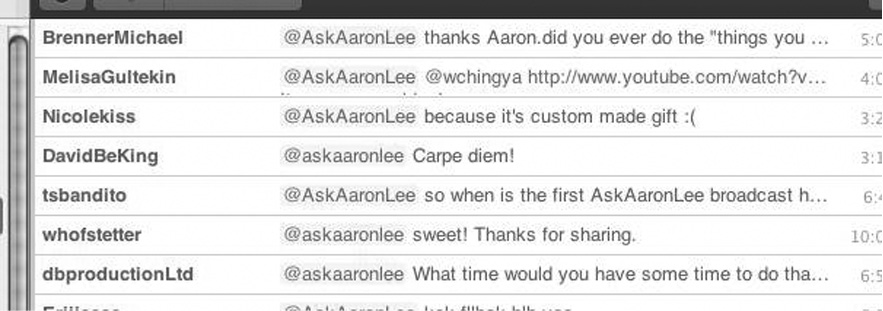
The Voice of Your Brand
Aaron always tells people “my blog is my thoughts and Twitter is my voice.”
Aaron uses cross-platform promotion (CPP) to unite the message of his blog with his personal brand growth using Twitter. “I was able to grow a strong brand on Twitter because I had a blog. AskAaronLee.com helped give people tips and advice about Twitter, and people appreciated it. My blog enables me to answer more questions and by doing so it indirectly helped me to grow a strong personal brand on Twitter too [see Figure 15-8]. Not only was I able to share my thoughts, I was able to share my expertise and what I know about Twitter. AskAaronLee.com has helped my branding so much that I landed a job in an agency even before graduating from university.”
Figure 15-8
Aaron’s blog (AskAaronLee.com) is a great example of using cross-platform promotion (CPP) to promote a personal brand.

Aaron’s personal brand voice continues to grow through his adaptive and insightful use of Twitter as a platform to echo his talents and vision. He is one of those early Twitter adopters who just had an instinctive knowledge of the power of the platform, perhaps even before the developers themselves.
His willingness to push the boundaries of what Twitter can provide in personal brand value is a truly inspirational story.

